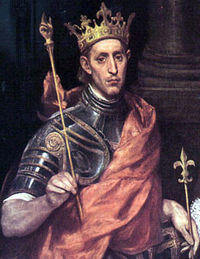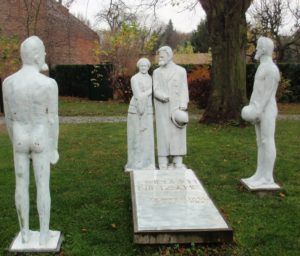On this day in 1270, France’s King Louis IX died at Tunis of dysentery at the age of 56. Born on 25 April 1215 in Poissy, near Paris. He was the sixth-great-grandson of Hugh Capet, and thus a member of the House of Capet, and the son of Louis VIII and Blanche of Castile. Louis went on two of the Crusades, in 1248 (Seventh Crusade) and then again in 1270 (Eighth Crusade). The only French king to be canonized. Louis married Margaret of Provence (1234-1270 his death).
 The Final Footprint – Christian tradition states that some of his entrails were buried directly on the spot in Tunisia, where a Tomb of Saint-Louis can still be visited today, whereas his heart and other parts of his entrails were sealed in an urn and placed in the Basilica of Monreale, Palermo, where they still remain. His body was entombed in Saint Denis Basilique in Saint-Denis, Ile-de-France Region, France. His tomb at Saint-Denis was a magnificent gilt brass monument designed in the late 14th century. It was melted down during the French Wars of Religion, at which time the body of the king disappeared. Only one finger was rescued and is kept at Saint-Denis. The city of St. Louis, Missouri was named after him. In early 1905 the Louisiana Purchase Exposition Company offered the city a bronze statue of the city’s patron saint. Called the Apothesis of St. Louis, the statue was made as a copy of the one designed by Charles Niehaus exhibited at the Louisiana Purchase Exposition (1904 World’s Fair). It was unveiled 4 October 1906. The inscription on the north base reads; “Presented to the City of St. Louis by the Louisiana Purchase Exposition in commemoration of the Universal Exposition of 1904 held on this site.” The monument became the symbol of the city. As final footprints go, very impressive. Which would you prefer; an extravagant final footprint or modest and subdued?
The Final Footprint – Christian tradition states that some of his entrails were buried directly on the spot in Tunisia, where a Tomb of Saint-Louis can still be visited today, whereas his heart and other parts of his entrails were sealed in an urn and placed in the Basilica of Monreale, Palermo, where they still remain. His body was entombed in Saint Denis Basilique in Saint-Denis, Ile-de-France Region, France. His tomb at Saint-Denis was a magnificent gilt brass monument designed in the late 14th century. It was melted down during the French Wars of Religion, at which time the body of the king disappeared. Only one finger was rescued and is kept at Saint-Denis. The city of St. Louis, Missouri was named after him. In early 1905 the Louisiana Purchase Exposition Company offered the city a bronze statue of the city’s patron saint. Called the Apothesis of St. Louis, the statue was made as a copy of the one designed by Charles Niehaus exhibited at the Louisiana Purchase Exposition (1904 World’s Fair). It was unveiled 4 October 1906. The inscription on the north base reads; “Presented to the City of St. Louis by the Louisiana Purchase Exposition in commemoration of the Universal Exposition of 1904 held on this site.” The monument became the symbol of the city. As final footprints go, very impressive. Which would you prefer; an extravagant final footprint or modest and subdued?
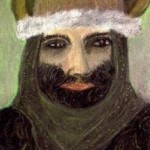 On this day, 25 August, in 1330, Sir James
On this day, 25 August, in 1330, Sir James of Douglas Scottish knight, friend and ablest warrior of Robert the Bruce, died fighting the Moors in Spain. Born c. 1286 in Douglas, Lanarkshire, Scotland. He was the eldest son of Sir William Douglas, known as “le Hardi” or “the bold”, who had been the first noble supporter of William Wallace. The Scots called him Good Sir James. The English called him Black Douglas. He commanded the left wing of Bruce’s army at Bannockburn. Before his death, Bruce asked Douglas to take his heart on a crusade to the Holy Land. Douglas set out bearing Bruce’s heart in a silver casket, but was killed before reaching the Holy Land.
of Douglas Scottish knight, friend and ablest warrior of Robert the Bruce, died fighting the Moors in Spain. Born c. 1286 in Douglas, Lanarkshire, Scotland. He was the eldest son of Sir William Douglas, known as “le Hardi” or “the bold”, who had been the first noble supporter of William Wallace. The Scots called him Good Sir James. The English called him Black Douglas. He commanded the left wing of Bruce’s army at Bannockburn. Before his death, Bruce asked Douglas to take his heart on a crusade to the Holy Land. Douglas set out bearing Bruce’s heart in a silver casket, but was killed before reaching the Holy Land.
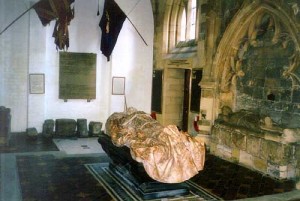 The Final Footprint – The Scottish knights who survived brought back Bruce’s heart, which was buried at Melrose Abbey, and Douglas’s body which was entombed in Saint Bride’s Cemetery in Douglas, Lanarkshire, Scotland. The plaque over his tomb reads; THE GOOD SIR JAMES OF DOUGLAS Killed in battle with the Moors in Spain while on his way to the Holy Land with the heart of King Robert the Bruce 25th August 1330.
The Final Footprint – The Scottish knights who survived brought back Bruce’s heart, which was buried at Melrose Abbey, and Douglas’s body which was entombed in Saint Bride’s Cemetery in Douglas, Lanarkshire, Scotland. The plaque over his tomb reads; THE GOOD SIR JAMES OF DOUGLAS Killed in battle with the Moors in Spain while on his way to the Holy Land with the heart of King Robert the Bruce 25th August 1330.
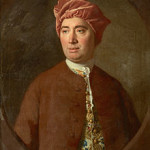 On this day in 1776, Scottish philosopher, historian, economist, and essayist, David Hume died at the south-west corner of St. Andrew’s Square in Edinburgh’s New Town, at what is now 21 Saint David Street, at the age of 65. Born David Home on 26 April 1711 (Old Style) in a tenement on the north side of the Lawnmarket in Edinburgh. Known especially for his philosophical empiricism and scepticism, he was, in my opinion, one of the most important figures in the history of Western philosophy and the Scottish Enlightenment. Hume is often grouped with John Locke, George Berkeley, and others as a British Empiricist. Beginning with his A Treatise of Human Nature (1739), Hume strove to create a total naturalistic “science of man” that examined the psychological basis of human nature. In stark opposition to the rationalists who preceded him, most notably Descartes, he concluded that desire rather than reason governed human behavior, saying: “Reason is, and ought only to be the slave of the passions“. A prominent figure in the sceptical philosophical tradition and a strong empiricist, he argued against the existence of innate ideas, concluding instead that humans have knowledge only of things they directly experience. Thus he divides perceptions between strong and lively “impressions” or direct sensations and fainter “ideas”, which are copied from impressions. He developed the position that mental behaviour is governed by “custom”, that is acquired ability; our use of induction, for example, is justified only by our idea of the “constant conjunction” of causes and effects. Without direct impressions of a metaphysical “self”, he concluded that humans have no actual conception of the self, only of a bundle of sensations associated with the self. Hume advocated a compatibilist theory of free will that proved extremely influential on subsequent moral philosophy. He was also a sentimentalist who held that ethics are based on feelings rather than abstract moral principles. Hume also examined the normative is–ought problem. He held notoriously ambiguous views of Christianity, but famously challenged the argument from design in his Dialogues Concerning Natural Religion (1777). Kant credited Hume with waking him up from his “dogmatic slumbers” and Hume has proved extremely influential on subsequent philosophy, especially on utilitarianism, logical positivism, philosophy of science, early analytic philosophy, cognitive philosophy, and other movements and thinkers. The philosopher Jerry Fodor proclaimed Hume’s Treatise “the founding document of cognitive science”. Also famous as a prose stylist, Hume pioneered the essay as a literary genre and engaged with contemporary intellectual luminaries such as Jean-Jacques Rousseau, Adam Smith (who acknowledged Hume’s influence on his economics and political philosophy), James Boswell, Joseph Butler, and Thomas Reid. Hume never married.
On this day in 1776, Scottish philosopher, historian, economist, and essayist, David Hume died at the south-west corner of St. Andrew’s Square in Edinburgh’s New Town, at what is now 21 Saint David Street, at the age of 65. Born David Home on 26 April 1711 (Old Style) in a tenement on the north side of the Lawnmarket in Edinburgh. Known especially for his philosophical empiricism and scepticism, he was, in my opinion, one of the most important figures in the history of Western philosophy and the Scottish Enlightenment. Hume is often grouped with John Locke, George Berkeley, and others as a British Empiricist. Beginning with his A Treatise of Human Nature (1739), Hume strove to create a total naturalistic “science of man” that examined the psychological basis of human nature. In stark opposition to the rationalists who preceded him, most notably Descartes, he concluded that desire rather than reason governed human behavior, saying: “Reason is, and ought only to be the slave of the passions“. A prominent figure in the sceptical philosophical tradition and a strong empiricist, he argued against the existence of innate ideas, concluding instead that humans have knowledge only of things they directly experience. Thus he divides perceptions between strong and lively “impressions” or direct sensations and fainter “ideas”, which are copied from impressions. He developed the position that mental behaviour is governed by “custom”, that is acquired ability; our use of induction, for example, is justified only by our idea of the “constant conjunction” of causes and effects. Without direct impressions of a metaphysical “self”, he concluded that humans have no actual conception of the self, only of a bundle of sensations associated with the self. Hume advocated a compatibilist theory of free will that proved extremely influential on subsequent moral philosophy. He was also a sentimentalist who held that ethics are based on feelings rather than abstract moral principles. Hume also examined the normative is–ought problem. He held notoriously ambiguous views of Christianity, but famously challenged the argument from design in his Dialogues Concerning Natural Religion (1777). Kant credited Hume with waking him up from his “dogmatic slumbers” and Hume has proved extremely influential on subsequent philosophy, especially on utilitarianism, logical positivism, philosophy of science, early analytic philosophy, cognitive philosophy, and other movements and thinkers. The philosopher Jerry Fodor proclaimed Hume’s Treatise “the founding document of cognitive science”. Also famous as a prose stylist, Hume pioneered the essay as a literary genre and engaged with contemporary intellectual luminaries such as Jean-Jacques Rousseau, Adam Smith (who acknowledged Hume’s influence on his economics and political philosophy), James Boswell, Joseph Butler, and Thomas Reid. Hume never married.
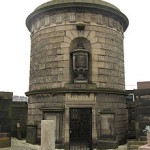 The Final Footprint – Hume asked that he be entombed in a “simple roman tomb.” In his will he requests that it be inscribed only with his name and the year of his birth and death, “leaving it to Posterity to add the Rest.” The Hume Family private mausoleum stands on the south-western slope of Calton Hill, in the Old Calton Cemetery in Edinburgh.
The Final Footprint – Hume asked that he be entombed in a “simple roman tomb.” In his will he requests that it be inscribed only with his name and the year of his birth and death, “leaving it to Posterity to add the Rest.” The Hume Family private mausoleum stands on the south-western slope of Calton Hill, in the Old Calton Cemetery in Edinburgh.
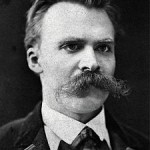 On this day in 1900, German philosopher, poet, composer and classical philologist, Friedrich Wilhelm Nietzsche died of a stroke in Weimar, Saxony, German Empire, at the age of 55. Born on 15 October 1844 in Röcken bei Lützen, Prussia. He wrote several critical texts on religion, morality, contemporary culture, philosophy and science, displaying a fondness for metaphor, irony and aphorism. Nietzsche’s key ideas include the Apollonian/Dionysian dichotomy, perspectivism, the Will to Power, the “death of God”, the Übermensch and eternal recurrence. Central to his philosophy is the idea of “life-affirmation”, which involves questioning of any doctrine that drains one’s expansive energies, however socially prevalent those ideas might be. His radical questioning of the value and objectivity of truth has been the focus of extensive commentary and his influence remains substantial, particularly in the continental philosophical tradition comprising existentialism, postmodernism, and post-structuralism. Nietzsche began his career as a classical philologist — a scholar of Greek and Roman textual criticism — before turning to philosophy. In 1869, at age twenty-four, he was appointed to the Chair of Classical Philology at the University of Basel, the youngest individual to have held this position. He resigned in the summer of 1879 due to health problems that plagued him most of his life. In 1889, at age forty-four, he suffered a collapse and a complete loss of his mental faculties. The breakdown was later ascribed to atypical general paresis due to tertiary syphilis, but this diagnosis has come into question. Nietzsche lived his remaining years in the care of his mother until her death in 1897, after which he fell under the care of his sister Elisabeth Förster-Nietzsche until his death in 1900. As his caretaker, his sister assumed the roles of curator and editor of Nietzsche’s manuscripts. Förster-Nietzsche was married to a prominent German nationalist and antisemite, Bernhard Förster, and reworked Nietzsche’s unpublished writings to fit her husband’s ideology, often in ways contrary to Nietzsche’s stated opinions, which were strongly and explicitly opposed to antisemitism and nationalism. Through Förster-Nietzsche’s editions, Nietzsche’s name became associated with German militarism and Nazism, although later twentieth-century scholars have attempted to counteract this misconception of his ideas. Nietzsche never married.
On this day in 1900, German philosopher, poet, composer and classical philologist, Friedrich Wilhelm Nietzsche died of a stroke in Weimar, Saxony, German Empire, at the age of 55. Born on 15 October 1844 in Röcken bei Lützen, Prussia. He wrote several critical texts on religion, morality, contemporary culture, philosophy and science, displaying a fondness for metaphor, irony and aphorism. Nietzsche’s key ideas include the Apollonian/Dionysian dichotomy, perspectivism, the Will to Power, the “death of God”, the Übermensch and eternal recurrence. Central to his philosophy is the idea of “life-affirmation”, which involves questioning of any doctrine that drains one’s expansive energies, however socially prevalent those ideas might be. His radical questioning of the value and objectivity of truth has been the focus of extensive commentary and his influence remains substantial, particularly in the continental philosophical tradition comprising existentialism, postmodernism, and post-structuralism. Nietzsche began his career as a classical philologist — a scholar of Greek and Roman textual criticism — before turning to philosophy. In 1869, at age twenty-four, he was appointed to the Chair of Classical Philology at the University of Basel, the youngest individual to have held this position. He resigned in the summer of 1879 due to health problems that plagued him most of his life. In 1889, at age forty-four, he suffered a collapse and a complete loss of his mental faculties. The breakdown was later ascribed to atypical general paresis due to tertiary syphilis, but this diagnosis has come into question. Nietzsche lived his remaining years in the care of his mother until her death in 1897, after which he fell under the care of his sister Elisabeth Förster-Nietzsche until his death in 1900. As his caretaker, his sister assumed the roles of curator and editor of Nietzsche’s manuscripts. Förster-Nietzsche was married to a prominent German nationalist and antisemite, Bernhard Förster, and reworked Nietzsche’s unpublished writings to fit her husband’s ideology, often in ways contrary to Nietzsche’s stated opinions, which were strongly and explicitly opposed to antisemitism and nationalism. Through Förster-Nietzsche’s editions, Nietzsche’s name became associated with German militarism and Nazism, although later twentieth-century scholars have attempted to counteract this misconception of his ideas. Nietzsche never married.
The Final Footprint – He was interred beside his father at the church in Röcken bei Lützen, Germany. His friend and secretary Peter Gast gave his funeral oration, proclaiming: “Holy be your name to all future generations!” Nietzsche had written in Ecce Homo (at that point still unpublished) of his fear that one day his name would be regarded as “holy”.
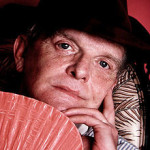 On this day in 1984, author Truman Capote died in the Los Angeles home of Joanne Carson, the former wife of Johnny Carson, from liver cancer at the age of 59. Born Truman Streckfus Persons on 30 September 1924 in New Orleans. Many of his short stories, novels, plays, and nonfiction are recognized literary classics, including the novella Breakfast at Tiffany’s (1958) and the true crime novel In Cold Blood (1966), which he labeled a “nonfiction novel.” At least 20 films and television dramas have been produced from Capote novels, stories and screenplays. Capote rose above a childhood troubled by divorce, a long absence from his mother, and multiple migrations. He had discovered his calling as a writer by the age of 11, and for the rest of his childhood he honed his writing ability. Capote began his professional career writing short stories. The critical success of one story, “Miriam” (1945), attracted the attention of Random House publisher Bennett Cerf, and resulted in a contract to write the novel Other Voices, Other Rooms (1948). Capote earned the most fame with In Cold Blood, a journalistic work about the murder of Herbert Clutter and his Kansas farm family in their home, a book Capote spent four years writing, with much help from his childhood friend, Harper Lee, who wrote To Kill a Mockingbird (1960) (The character Dill is apparently based on Capote). A milestone in popular culture, In Cold Blood was the peak of Capote’s literary career; it was to be his final fully published book. In the 1970s, he maintained his celebrity status by appearing on television talk shows.
On this day in 1984, author Truman Capote died in the Los Angeles home of Joanne Carson, the former wife of Johnny Carson, from liver cancer at the age of 59. Born Truman Streckfus Persons on 30 September 1924 in New Orleans. Many of his short stories, novels, plays, and nonfiction are recognized literary classics, including the novella Breakfast at Tiffany’s (1958) and the true crime novel In Cold Blood (1966), which he labeled a “nonfiction novel.” At least 20 films and television dramas have been produced from Capote novels, stories and screenplays. Capote rose above a childhood troubled by divorce, a long absence from his mother, and multiple migrations. He had discovered his calling as a writer by the age of 11, and for the rest of his childhood he honed his writing ability. Capote began his professional career writing short stories. The critical success of one story, “Miriam” (1945), attracted the attention of Random House publisher Bennett Cerf, and resulted in a contract to write the novel Other Voices, Other Rooms (1948). Capote earned the most fame with In Cold Blood, a journalistic work about the murder of Herbert Clutter and his Kansas farm family in their home, a book Capote spent four years writing, with much help from his childhood friend, Harper Lee, who wrote To Kill a Mockingbird (1960) (The character Dill is apparently based on Capote). A milestone in popular culture, In Cold Blood was the peak of Capote’s literary career; it was to be his final fully published book. In the 1970s, he maintained his celebrity status by appearing on television talk shows.
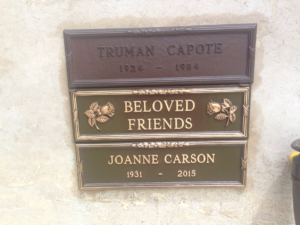
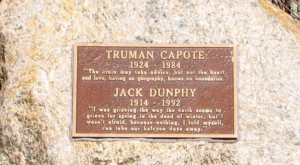 The Final Footprint – Capote was cremated. A portion of his cremains are inurned in Westwood Memorial Park in Los Angeles and a portion were scattered with those of his companion Jack Dunphy at Crooked Pond in Long Island, New York. His epitaph reads;
The Final Footprint – Capote was cremated. A portion of his cremains are inurned in Westwood Memorial Park in Los Angeles and a portion were scattered with those of his companion Jack Dunphy at Crooked Pond in Long Island, New York. His epitaph reads;
“The brain may take advice, but not the heart, and love, having no geography, knows no boundaries.”
Capote’s will provided that after Dunphy’s death a literary trust would be established, sustained by revenues from Capote’s works, to fund various literary prizes, fellowships and scholarships, including the Truman Capote Award for Literary Criticism in Memory of Newton Arvin, the Smith College professor and critic, who lost his job after his homosexuality was exposed. As such, the Truman Capote Literary Trust was established in 1994, two years after Dunphy’s death. Other notable final footprints at Westwood include; Ray Bradbury, Sammy Cahn, James Coburn, Rodney Dangerfield, Janet Leigh, Farrah Fawcett, Hugh Hefner, Brian Keith, Don Knotts, Burt Lancaster, Peter Lawford, Peggy Lee, Jack Lemmon, Karl Malden, Dean Martin, Walter Mathau, Marilyn Monroe, Carroll O’Connor, Roy Orbison, George C. Scott, Dorothy Stratten, Natalie Wood, and Frank Zappa.
 On this day in 2001, American R&B recording artist, actress and model Aaliyah died when the plane she was a passenger on, crashed in Marsh Harbour, Abaco Island, The Bahamas. She was 22. Born Aaliyah Dana Haughton on 16 January 1979, in Brooklyn, New York. At age 12, Aaliyah signed with Jive Records and her uncle Barry Hankerson’s Blackground Records. Hankerson introduced her to R. Kelly, who became her mentor, as well as lead songwriter and producer of her debut album, Age Ain’t Nothing but a Number. Aaliyah worked with record producers Timbaland and Missy Elliott for her second album, One in a Million. In 2000, Aaliyah appeared in her first major film, Romeo Must Die. She contributed to the film’s soundtrack, which spawned the single “Try Again”. The song topped the Billboard Hot 100 solely on airplay, making Aaliyah the first artist in Billboard history to achieve this feat. “Try Again” earned Aaliyah a Grammy Award nomination for Best Female R&B Vocalist. After completing Romeo Must Die, Aaliyah filmed her part in Queen of the Damned, a loose adaptation of the third novel of Anne Rice’s The Vampire Chronicles. She released her third and final album, Aaliyah, in July 2001.
On this day in 2001, American R&B recording artist, actress and model Aaliyah died when the plane she was a passenger on, crashed in Marsh Harbour, Abaco Island, The Bahamas. She was 22. Born Aaliyah Dana Haughton on 16 January 1979, in Brooklyn, New York. At age 12, Aaliyah signed with Jive Records and her uncle Barry Hankerson’s Blackground Records. Hankerson introduced her to R. Kelly, who became her mentor, as well as lead songwriter and producer of her debut album, Age Ain’t Nothing but a Number. Aaliyah worked with record producers Timbaland and Missy Elliott for her second album, One in a Million. In 2000, Aaliyah appeared in her first major film, Romeo Must Die. She contributed to the film’s soundtrack, which spawned the single “Try Again”. The song topped the Billboard Hot 100 solely on airplay, making Aaliyah the first artist in Billboard history to achieve this feat. “Try Again” earned Aaliyah a Grammy Award nomination for Best Female R&B Vocalist. After completing Romeo Must Die, Aaliyah filmed her part in Queen of the Damned, a loose adaptation of the third novel of Anne Rice’s The Vampire Chronicles. She released her third and final album, Aaliyah, in July 2001.
 The Final Footprint – Aaliyah’s funeral was held on 31 August 2001, at the Saint Ignatius Loyola Church in New York. Her body was placed in a silver casket, which was carried in a glass hearse and was drawn by horse. Among those in attendance to the private ceremony were Missy Elliott, Timbaland, Gladys Knight, Lil’ Kim and Sean Combs. After the service, 22 white doves were released to symbolize each year of Aaliyah’s life. The service was conducted by Frank E. Campbell Funeral Home, a Dignity Memorial location. She is entombed in a crypt in a private room in the Rosewood Mausoleum at the Ferncliff Cemetery in Hartsdale, New York. Other notable funerals at Frank E. Campbell include; Irving Berlin, Lord Buckley, James Cagney, Oleg Cassini, Montgomery Clift, Frank Costello, Joan Crawford, Malcolm Forbes, Greta Garbo, Judy Garland, George Gershwin, Jim Henson, Peter Jennings, Jacqueline Kennedy Onassis, Heath Ledger, John Lennon, Norman Mailer, Bat Masterson, Notorious B.I.G., Les Paul, Ayn Rand, Igor Stravinsky, Ed Sullivan, Arturo Toscanini, Rudolf Valentino, Luther Vandross, and Tennessee Williams. Other notable Final Footprints at Ferncliff include: Harold Arlen, James Baldwin, Béla Bartók, Cab Calloway, Joan Crawford, Ossie Davis, Ruby Dee, Oscar Hammerstein II, Jerome Kern, Thelonious Monk, and Toots Shor. Diane Arbus, John Lennon, Alan Jay Lerner, Nelson Rockefeller, and Christopher Reeve were cremated at Ferncliff.
The Final Footprint – Aaliyah’s funeral was held on 31 August 2001, at the Saint Ignatius Loyola Church in New York. Her body was placed in a silver casket, which was carried in a glass hearse and was drawn by horse. Among those in attendance to the private ceremony were Missy Elliott, Timbaland, Gladys Knight, Lil’ Kim and Sean Combs. After the service, 22 white doves were released to symbolize each year of Aaliyah’s life. The service was conducted by Frank E. Campbell Funeral Home, a Dignity Memorial location. She is entombed in a crypt in a private room in the Rosewood Mausoleum at the Ferncliff Cemetery in Hartsdale, New York. Other notable funerals at Frank E. Campbell include; Irving Berlin, Lord Buckley, James Cagney, Oleg Cassini, Montgomery Clift, Frank Costello, Joan Crawford, Malcolm Forbes, Greta Garbo, Judy Garland, George Gershwin, Jim Henson, Peter Jennings, Jacqueline Kennedy Onassis, Heath Ledger, John Lennon, Norman Mailer, Bat Masterson, Notorious B.I.G., Les Paul, Ayn Rand, Igor Stravinsky, Ed Sullivan, Arturo Toscanini, Rudolf Valentino, Luther Vandross, and Tennessee Williams. Other notable Final Footprints at Ferncliff include: Harold Arlen, James Baldwin, Béla Bartók, Cab Calloway, Joan Crawford, Ossie Davis, Ruby Dee, Oscar Hammerstein II, Jerome Kern, Thelonious Monk, and Toots Shor. Diane Arbus, John Lennon, Alan Jay Lerner, Nelson Rockefeller, and Christopher Reeve were cremated at Ferncliff.
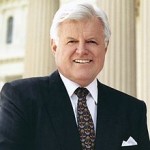 And on this day in 2009, younger brother of JFK and RFK, United States Senator from Massachusetts and a member of the Democratic Party, Edward Kennedy died of brain cancer at his home in Hyannis Port, Massachusetts at the age of 77, two weeks after the death of his sister, Eunice Kennedy Shriver. Born Edward Moore Kennedy on 22 February 1932 in Boston. He was the second most senior member of the Senate when he died and was the fourth-longest-serving senator in United States history, having served there for almost 47 years. As the most prominent living member of the Kennedy family for many years, he was also the last surviving son of Joseph P. Kennedy, Sr. and the father of Congressman Patrick J. Kennedy. Kennedy entered the Senate in a November 1962 special election to fill the seat once held by his brother John. He was elected to a full six-year term in 1964 and was reelected seven more times before his death. The Chappaquiddick incident on July 18, 1969, resulted in the death of his automobile passenger Mary Jo Kopechne. Kennedy pleaded guilty to a charge of leaving the scene of an accident and the incident significantly damaged his chances of ever becoming President of the United States. His one attempt, in the 1980 presidential election, resulted in a Democratic primary campaign loss to incumbent President Jimmy Carter. Kennedy was known for his charisma and oratorical skills. His 1968 eulogy for his brother Robert and his 1980 rallying cry for modern American liberalism were among his best-known speeches. He became recognized as “The Lion of the Senate” through his long tenure and influence. More than 300 bills that Kennedy and his staff authored were enacted into law. Unabashedly liberal, Kennedy championed an interventionist government emphasizing economic and social justice, but was also known for working with Republicans to find compromises between senators with disparate views. Kennedy played a major role in passing many laws, including laws addressing immigration, cancer research, health insurance, apartheid, disability discrimination, AIDS care, civil rights, mental health benefits, children’s health insurance, education and volunteering. During the 2000s, he led several unsuccessful immigration reform efforts. Over the course of his Senate career and continuing into the Obama administration, Kennedy continued his efforts to enact universal health care, which he called the “cause of my life.” Kennedy married twice: Virginia Joan Bennett (1958 – 1982 divorce) and Victoria Anne Reggie (1992 – 2009 his death).
And on this day in 2009, younger brother of JFK and RFK, United States Senator from Massachusetts and a member of the Democratic Party, Edward Kennedy died of brain cancer at his home in Hyannis Port, Massachusetts at the age of 77, two weeks after the death of his sister, Eunice Kennedy Shriver. Born Edward Moore Kennedy on 22 February 1932 in Boston. He was the second most senior member of the Senate when he died and was the fourth-longest-serving senator in United States history, having served there for almost 47 years. As the most prominent living member of the Kennedy family for many years, he was also the last surviving son of Joseph P. Kennedy, Sr. and the father of Congressman Patrick J. Kennedy. Kennedy entered the Senate in a November 1962 special election to fill the seat once held by his brother John. He was elected to a full six-year term in 1964 and was reelected seven more times before his death. The Chappaquiddick incident on July 18, 1969, resulted in the death of his automobile passenger Mary Jo Kopechne. Kennedy pleaded guilty to a charge of leaving the scene of an accident and the incident significantly damaged his chances of ever becoming President of the United States. His one attempt, in the 1980 presidential election, resulted in a Democratic primary campaign loss to incumbent President Jimmy Carter. Kennedy was known for his charisma and oratorical skills. His 1968 eulogy for his brother Robert and his 1980 rallying cry for modern American liberalism were among his best-known speeches. He became recognized as “The Lion of the Senate” through his long tenure and influence. More than 300 bills that Kennedy and his staff authored were enacted into law. Unabashedly liberal, Kennedy championed an interventionist government emphasizing economic and social justice, but was also known for working with Republicans to find compromises between senators with disparate views. Kennedy played a major role in passing many laws, including laws addressing immigration, cancer research, health insurance, apartheid, disability discrimination, AIDS care, civil rights, mental health benefits, children’s health insurance, education and volunteering. During the 2000s, he led several unsuccessful immigration reform efforts. Over the course of his Senate career and continuing into the Obama administration, Kennedy continued his efforts to enact universal health care, which he called the “cause of my life.” Kennedy married twice: Virginia Joan Bennett (1958 – 1982 divorce) and Victoria Anne Reggie (1992 – 2009 his death).
 The Final Footprint – Kennedy’s body traveled from the Kennedy Compound in Hyannis Port to the John F. Kennedy Library in Boston where it lay in repose and where over 50,000 members of the public filed by to pay their respects. On Saturday, 29 August, a procession traveled from the library to the Our Lady of Perpetual Help Basilica in Boston, for a funeral Mass. Present at the funeral service were President Obama and former Presidents Jimmy Carter, Bill Clinton and George W. Bush, Tony Bennett, Placido Domingo, Jack Nicholson, Yo-Yo Ma, Lauren Bacall and Bill Russell. Kennedy’s body was returned to Washington, D.C. for burial at Arlington National Cemetery near the graves of his brothers. Kennedy’s grave marker is identical to his brother Robert’s: a white oak cross and a marble white foot marker bearing his full name, year of birth and death. Other notable Final Footprints at Arlington include; the Space Shuttle Columbia, the Space Shuttle Challenger, Medgar Evers, John F. Kennedy, Jacqueline Bouvier Kennedy Onassis, Robert F. Kennedy, Lee Marvin, Audie Murphy, and Malcolm Kilduff, Jr.
The Final Footprint – Kennedy’s body traveled from the Kennedy Compound in Hyannis Port to the John F. Kennedy Library in Boston where it lay in repose and where over 50,000 members of the public filed by to pay their respects. On Saturday, 29 August, a procession traveled from the library to the Our Lady of Perpetual Help Basilica in Boston, for a funeral Mass. Present at the funeral service were President Obama and former Presidents Jimmy Carter, Bill Clinton and George W. Bush, Tony Bennett, Placido Domingo, Jack Nicholson, Yo-Yo Ma, Lauren Bacall and Bill Russell. Kennedy’s body was returned to Washington, D.C. for burial at Arlington National Cemetery near the graves of his brothers. Kennedy’s grave marker is identical to his brother Robert’s: a white oak cross and a marble white foot marker bearing his full name, year of birth and death. Other notable Final Footprints at Arlington include; the Space Shuttle Columbia, the Space Shuttle Challenger, Medgar Evers, John F. Kennedy, Jacqueline Bouvier Kennedy Onassis, Robert F. Kennedy, Lee Marvin, Audie Murphy, and Malcolm Kilduff, Jr.
Have you planned yours yet?
Follow TFF on twitter @RIPTFF

